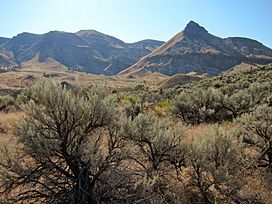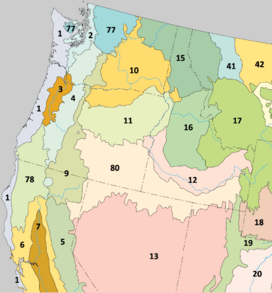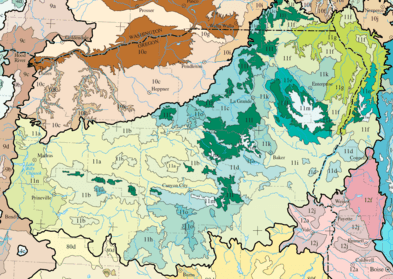Blue Mountains (ecoregion) facts for kids
Quick facts for kids Blue Mountains |
|
|---|---|

John Day Fossil Beds National Monument
|
|

Level III ecoregions in the Pacific Northwest: the Blue Mountains are marked 11
|
|
| Ecology | |
| Realm | Nearctic |
| Biome | Temperate coniferous forests |
| Borders |
List
|
| Geography | |
| Country | United States |
| States | Oregon, Idaho and Washington |
The Blue Mountains ecoregion is a special natural area in the Pacific Northwest. It's mostly in Oregon, but also stretches into Idaho and southeastern Washington. An "ecoregion" is a large area of land or water that has its own unique mix of plants, animals, and ecosystems. This particular ecoregion is named after the Blue Mountains.
Contents
Setting the Scene
This ecoregion starts near Redmond in Central Oregon. It then spreads across a big part of the Columbia Plateau in Eastern Oregon. Finally, it reaches Hells Canyon on the Snake River, where Oregon, Idaho, and Washington meet.
The Blue Mountains are part of this area. They are generally lower and more open than the nearby Cascades and Northern Rocky Mountains. However, they still have some very steep parts. For example, Hells Canyon is North America's deepest gorge, dropping 1,660 meters (5,450 feet)!
The mountains here include the Strawberry Range, Greenhorn, Elkhorn, Aldrich, and Maury Mountains. To the west are the gentler Ochoco Mountains. To the east are the rugged Wallowa Mountains. Important rivers like the Grande Ronde, Powder River, Malheur River, John Day, and Umatilla River flow through this region.
Most of the Blue Mountains were formed by volcanoes. This is similar to the Cascades. However, the very center of the Blue Mountains, including the highest ranges like the Wallowa and Elkhorn mountains, are made of different kinds of rock. These include granitic rocks, deep sea sediments, and metamorphosed rocks.
Amazing Plants
The Blue Mountains ecoregion has many different types of natural homes, called habitats. These include dry shrublands, bluebunch grasslands, pine forests, and high alpine areas. Riverbanks and wetlands are also important habitats.
This area is home to some of North America's biggest stands of very old trees, known as old-growth forests. You can find huge ponderosa pine trees here. Other important trees include Englemann spruce, western larch, and grand fir.
You'll also see plants like sagebrush and juniper. Other trees like Douglas fir and lodgepole pine grow here too. The ecoregion also has many shrubs, meadows, grasslands, and special plants that grow in high mountain areas.
Cool Animals
The Blue Mountains are full of wildlife! Many birds live here, including the majestic bald eagle and the northern spotted owl. You might also spot Lewis's woodpecker, Williamson's sapsucker, and red-breasted nuthatch. The riverbanks are especially important for many types of birds, including those that migrate.
Large mammals roam the mountain grasslands. This includes elk, and Hells Canyon is home to the largest elk herd in North America! You can also see bighorn sheep and mule deer. The rivers and streams are home to native fish like Chinook Salmon, Steelhead, Redband Trout, Coho Salmon, Bull Trout, and Pacific Lamprey.
Challenges and Protection
Sadly, these beautiful habitats are facing threats. Logging, livestock grazing, and efforts to control rivers and fires have impacted the land. Only about 10% of the original forest is still untouched.
A lot of the land in this region is managed by the United States Forest Service and the Bureau of Land Management. Much of it is used for grazing cattle.
However, there are still large areas of intact forest that are being protected. These include places like the Eagle Cap Wilderness in the Wallowa–Whitman National Forest, the Hells Canyon National Recreation Area, and the Strawberry Mountain Wilderness. Even so, these areas are often separated from each other, and logging, especially of ponderosa pine, is still a concern.
Level IV Ecoregions
The Blue Mountains ecoregion is quite large and diverse. To help understand it better, scientists have divided it into fourteen smaller areas. These are called Level IV ecoregions. Each of these smaller areas has its own unique features, like different types of land, plants, and animals.
- John Day/Clarno Uplands (11a): These are semi-dry hills and low mountains with grasslands and some juniper trees.
- John Day/Clarno Highlands (11b): These are higher hills and mountains mostly covered in ponderosa pine forests.
- Maritime-Influenced Zone (11c): This area gets more moisture from the ocean, supporting dense forests of ponderosa pine and Douglas-fir.
- Melange (11d): This region has complex geology, with mixed rock types and forests of Douglas-fir, ponderosa pine, and lodgepole pine.
- Wallowas/Seven Devils Mountains (11e): These are deeply cut mountains with forests that vary depending on how much moisture they get.
- Canyons and Dissected Highlands (11f): This area includes steep river canyons and plateaus with Douglas-fir and larch forests.
- Canyons and Dissected Uplands (11g): These are deep river canyons, like Hells Canyon, with dry, stony slopes and some forests.
- Continental Zone Highlands (11h): This is a mountainous area with extreme temperatures and mostly ponderosa pine forests.
- Continental Zone Foothills (11i): These are foothills and hills that experience a dry, continental climate, with sagebrush steppe and some forests.
- Blue Mountain Basins (11k): These are flat to rolling valleys, like the Wallowa and Grande Ronde valleys, with grasslands and wetlands.
- Mesic Forest Zone (11l): This zone has the highest forested areas in the Blue Mountains, with productive spruce-fir forests due to higher rainfall.
- Subalpine-Alpine Zone (11m): This includes very high mountains with glaciers, alpine meadows, and forests of subalpine fir and whitebark pine near the treeline.
- Deschutes River Valley (11n): This is a broad valley with the Deschutes River, known for its irrigated farms and sagebrush steppe.
- Cold Basins (11o): These are cold, wet valleys and meadows, often used for grazing, with sedges and grasses.


